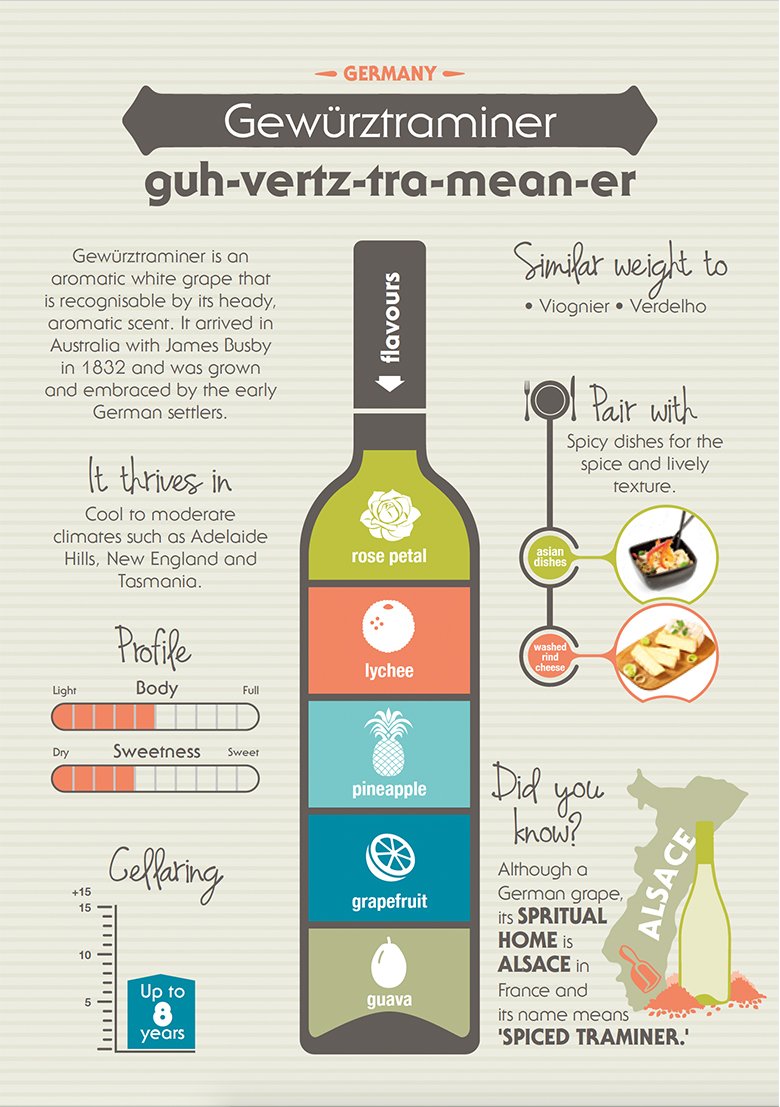Gewürztraminer (ga-VERTZ-trah-mee-ner) is a white wine grape originating in the Alsace region of France. It is a classic grape that likes cool climates like northeast France, Germany, and northern Italy, and is used to make a white wine of the same name. While not as well known as chardonnay and pinot grigio, it is typically very affordable and pairs well with spicy, flavorful foods. The predominant nose and flavor is lychee—a sweet, tropical fruit. It is higher in alcohol than comparable white wines.
Gewürztraminer is like the grown-up version of Moscato. While Gewürztraminer wine has many similarities to Moscato it also has higher alcohol, more striking aromatics and lower acidity. All of these characteristics make Gewürztraminer more difficult to slurp down, thus making it more ‘adult’.
It’s common to find pineapple, mango, passion fruit, peach, pear, rose, potpourri, tea, cinnamon, clove, allspice, wet rock, and sometimes soap notes, depending upon where the wine is from, and how it is made. The fruit in this wine is often very ripe, sometimes smelling like canned fruit!
Types of Structure
Medium Plus Body
Think of that weight as a liquid scale, from water (light body) to heavy cream (full body) in your mouth. Gewürztraminer is on the fuller side for white wines! Both alcohol and the presence of residual sugar contribute to this!
Medium Minus Acid
You can judge acidity based on whether your mouth waters after you take a sip of something. The more you salivate, the higher the acid. Gewürztraminer has very low acidity when it comes to whites.
Medium Plus Alcohol
You can feel alcohol ‘burn’ the back of your throat when you take a sip. Gewürztraminer is usually on the higher end.
Grapes and Wine Regions
Gewürztraminer comes from the border of France and Germany, and many of the best bottles still come from the two countries. The grapes like cold climates and clay soils, making it ideal for growing in Alsace, Germany, Alto Adige in northern Italy, Sonoma, and New York. The pink grapes are grown in the spring and summer and harvested in the fall, with some remaining on the vines longer for a sweeter, dessert-like wine.
Food Pairings
While Gewürztraminer may show a dry or sweet style, the sweeter themes tend to partner best with dishes that carry a little heat. The white wine pairs remarkably well with hot Thai or Asian dishes as well as spice-heavy Middle Eastern and Moroccan dishes. Try serving a dry or off-dry Gewürztraminer with a Moroccan chicken tagine, Thai crab curry, or Korean barbecue chicken wings. A decidedly sweet bottle complements a low-key fruit dessert such as apple strudel.
Serve Gewürztraminer well-chilled in a white wine glass. Not built to age well, drink Gewurztraminer sooner rather than later upon release.
Key Producers, Brands, and Buying Tips
When searching for Gewürztraminer at the store, look for smaller producers and higher quality wines rather than the cheap grocery store options. Even high-quality bottles rarely top $20 or $30 a bottle, making it an affordable option. Good Gewürztraminer can be found in wine shops and on restaurant wine lists. If you can't find it at your local shop, have them order you a few bottles or swap for a pinot grigio or Moscato.
Sources:
www.thespruceeats.com/gewurztraminer-wine-grapes
thegrapegrind.com/all-you-need-to-know-about-gewurztraminer-a-quick-guide/




